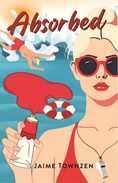
 |
What at first seems like a teenage beach read turns into a tribute to art’s place in a young woman’s life. All Stacey wants is to enjoy the summer before her senior year of high school in Mesa Valley, California. Getting a job at the local pool and working with her crush, Jessie, is a great start. But she worries she won’t fit in with the crew, and nothing her encouraging art teacher, Ms Moreno, says makes her feel any better.
Stacey’s struggles to obtain her optimal lifeguard “look” at the beginning are, fittingly, agonizing to read. The tone is obsessive, and the pace frantic, as if perfection, in the form of perfect attire, cannot come soon enough. By the second part of the book, Stacey is dissatisfied with her efforts to fit in, which is reflected in the self-portrait she makes in art class. Ms Moreno comments that it succeeds because it’s not pretty. Instead, it reveals Stacey’s crumpled self-image in the face of the unattainable expectations she’s up against. The book’s portrait of teenage angst works as catharsis and creative release. Ska, grunge, and 1990s indie-rock music references are a vibrant backdrop to Stacey’s concerns.
As a fatal accident at the pool, in the final third, forces Stacey to move beyond appearances, the book offers a satisfying resolution. The pace calms when Stacey answers, with precision and specificity, an investigator’s questions about the incident. Telling the truth, she then finds her stride, holding candid discussions with Jessie and other friends. Stacey changes from the inside out. Her artistic development, resulting in song lyrics and paintings, is a story within a story. What she learns and applies in her life about perspective, expression, and letting go inspires the book’s audience, too.
RECOMMENDED by the US Review